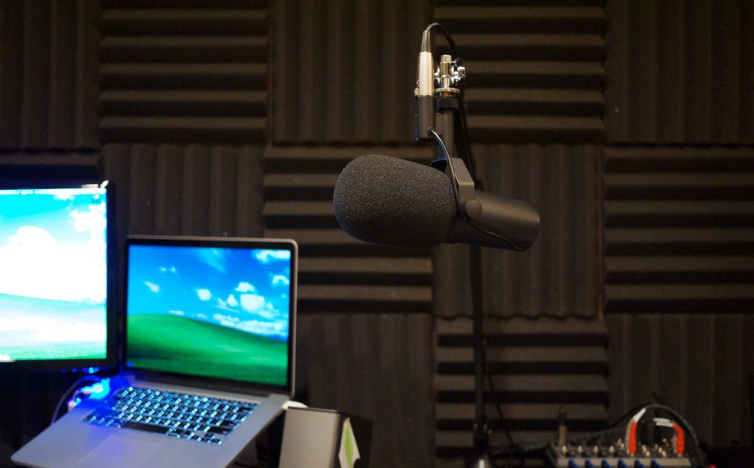Creating a high-quality podcast studio requires a well-thought-out plan to achieve the best acoustics and soundproofing. Avoiding common mistakes will not only enhance the audio quality but also improve the recording experience for both the host and the guest. Here’s a guide to help you steer clear of the most frequent errors when building an acoustic podcast studio.
1. Neglecting Proper Soundproofing
Importance of Soundproofing
One of the biggest mistakes is overlooking the importance of soundproofing, which blocks external noise from disrupting recordings. Without soundproofing, even the quietest background sounds, like HVAC systems or traffic, can seep into recordings and lower audio quality.
Solution: Effective Soundproofing Materials
Invest in soundproofing materials such as mass-loaded vinyl, acoustic door seals, and high-quality soundproof windows. This will help keep unwanted noises out and ensure that your recordings stay clear and professional.
2. Using the Wrong Acoustic Panels
Choosing the Right Acoustic Treatment
Another common mistake is selecting acoustic treatments that don’t match the room’s needs. Many opt for foam panels, but while foam can help with some echo reduction, it doesn’t absorb lower frequencies effectively.
Solution: Variety in Acoustic Treatments
Use a combination of bass traps, diffusers, and broadband absorbers to address a broader range of frequencies. The right acoustic treatment will improve sound clarity, making voices sound more natural and professional.
3. Poor Microphone Placement

Effects of Incorrect Microphone Positioning
Incorrectly placed microphones can pick up unnecessary room sounds and lead to poor audio quality. Many podcasters underestimate how sensitive microphones are to placement.
Solution: Strategic Microphone Setup
Place microphones away from walls and ensure they are positioned at the right height and distance from speakers. Use a pop filter to minimize plosives, and consider shock mounts to reduce vibrations from desk movements.
See Also: Top Tips for Soundproofing Your Podcast Studio
4. Ignoring Room Shape and Size
Impact of Room Shape on Acoustics
The size and shape of your recording space can significantly affect sound quality. Square or rectangular rooms can create problematic reflections and bass buildup, while very large or small rooms can lead to echo and reverb issues.
Solution: Optimize Your Room’s Layout
If possible, choose a room that is neither perfectly square nor has a large, empty space. Smaller rooms with proper acoustic treatment work well, as they reduce the chances of reflections and reverb. Consider filling the room with soft furniture, like couches or rugs, to help absorb sound naturally.
5. Overlooking Ventilation Needs
Importance of Silent Ventilation
Recording in a closed room without ventilation can lead to discomfort, but adding a ventilation system that creates noise is another issue. This is a common mistake, as podcasters often forget the importance of fresh air during long recording sessions.
Solution: Install Quiet Ventilation Options
Use a quiet HVAC or ventilation system that won’t interfere with the recording. Alternatively, consider adding acoustic baffles or soundproofing around existing vents to keep them quiet while maintaining airflow.
6. Relying Only on DIY Soundproofing Solutions
Limitations of DIY Soundproofing
While DIY solutions may be budget-friendly, they don’t always provide adequate sound isolation for professional-quality recordings. Using blankets or egg crates may slightly improve acoustics, but they won’t address all soundproofing needs.
Solution: Invest in Professional Acoustic Treatments
For a truly professional setup, invest in acoustic panels, bass traps, and diffusers designed for sound recording. If budget is a constraint, consider hybrid approaches, like using affordable yet effective materials, but don’t rely solely on DIY fixes for your studio’s acoustics.
See Also: The Importance of Acoustic Treatment in Podcast Studios
7. Not Testing and Adjusting Acoustics
The Importance of Room Testing
One mistake many podcasters make is assuming their room setup is perfect without testing the acoustics. Every space has unique sound characteristics, so it’s essential to test your setup before recording.
Solution: Regular Testing and Calibration
Before launching a podcast, do test recordings to listen for echo, reverb, or external noises. Make adjustments as needed, whether that involves changing panel placement, adjusting microphone levels, or rearranging furniture to improve sound quality.
8. Skipping Room Calibration Tools
Benefits of Using Calibration Software
Some podcasters overlook the importance of calibration tools that help detect and correct room acoustics. Without these, it’s challenging to know how well the room is truly optimized.
Solution: Use Calibration Software and Tools
Invest in calibration software or an acoustic measurement microphone to assess your room’s sound. These tools can reveal acoustic weaknesses that aren’t always noticeable by ear alone, allowing for more precise adjustments.
Call us: Contact DeSound Soundproofing Expert in Dubai For Soundproofing: +971 56 231 4204
By avoiding these common mistakes, you can create a podcast studio with acoustics that elevate the quality of your recordings. A well-prepared, acoustically balanced room will enhance the listener experience and ensure your podcast sounds polished and professional.

